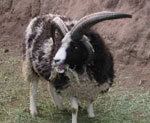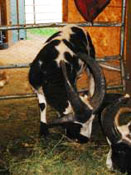The information on this page about Jacob sheep was provided by the Jacob Sheep Breeders Association.
 Size. The Jacob is a small to medium size breed. Adult ewes range from 80 to 120 pounds, while rams range from 120 to 180 pounds. Size. The Jacob is a small to medium size breed. Adult ewes range from 80 to 120 pounds, while rams range from 120 to 180 pounds.
Coloration. Ideally, coloration of this spotted breed should be 60% white with 40% random black or lilac spots or patches over the body
 Horns. Jacob sheep carry the polycerate gene, allowing them to produce 2, 4, or 6 horns in both ewes and rams. Ram horns can reach 30 inches in length or more. Horns. Jacob sheep carry the polycerate gene, allowing them to produce 2, 4, or 6 horns in both ewes and rams. Ram horns can reach 30 inches in length or more.
Fleeces. The fleeces from Jacobs are a delight for handspinners and for the connoisseur of natural color. They are light and open, weighing between 3 and 6 pounds and having a staple length of 3 to 7 inches. They part easily, exposing a soft, medium grade wool with healthy luster and sheen. Due to the spotting of these animals, the wool can be spun into a complete spectrum from white through gray/lilac to black.
 Origin. Jacob Sheep are a very ancient, domesticated breed that probably originated in Syria some 3000 years ago. Pictorial evidence traces the breed's movement through North Africa, Sicily, Spain, and on to England. Jacob sheep were imported into the U.S. in the early 1900's for game parks and zoos. The genetic pool was greatly enhanced by additional importations from Britain during the 1950's and 1960's. This unique breed of sheep takes it's name from Jacob, father of the 12 Hebrew patriarchs. Origin. Jacob Sheep are a very ancient, domesticated breed that probably originated in Syria some 3000 years ago. Pictorial evidence traces the breed's movement through North Africa, Sicily, Spain, and on to England. Jacob sheep were imported into the U.S. in the early 1900's for game parks and zoos. The genetic pool was greatly enhanced by additional importations from Britain during the 1950's and 1960's. This unique breed of sheep takes it's name from Jacob, father of the 12 Hebrew patriarchs.
 General. Handsome and hardy, the Jacob is ideal for the small flock owner or the large breeder. They are a small and efficient breed, allowing more sheep per acre. They are easily handled, rarely need veterinarian care, and show a good resistance to parasites and foot-related problems. Ewes lamb easily and the lambs are up and nursing quickly. Carcasses are lean and flavorful, with minimal waste. Tanned hides and horns for buttons and walking stick handles are additional unique products from these sheep. General. Handsome and hardy, the Jacob is ideal for the small flock owner or the large breeder. They are a small and efficient breed, allowing more sheep per acre. They are easily handled, rarely need veterinarian care, and show a good resistance to parasites and foot-related problems. Ewes lamb easily and the lambs are up and nursing quickly. Carcasses are lean and flavorful, with minimal waste. Tanned hides and horns for buttons and walking stick handles are additional unique products from these sheep.
|
 Size. The Jacob is a small to medium size breed. Adult ewes range from 80 to 120 pounds, while rams range from 120 to 180 pounds.
Size. The Jacob is a small to medium size breed. Adult ewes range from 80 to 120 pounds, while rams range from 120 to 180 pounds. Horns. Jacob sheep carry the polycerate gene, allowing them to produce 2, 4, or 6 horns in both ewes and rams. Ram horns can reach 30 inches in length or more.
Horns. Jacob sheep carry the polycerate gene, allowing them to produce 2, 4, or 6 horns in both ewes and rams. Ram horns can reach 30 inches in length or more. Origin. Jacob Sheep are a very ancient, domesticated breed that probably originated in Syria some 3000 years ago. Pictorial evidence traces the breed's movement through North Africa, Sicily, Spain, and on to England. Jacob sheep were imported into the U.S. in the early 1900's for game parks and zoos. The genetic pool was greatly enhanced by additional importations from Britain during the 1950's and 1960's. This unique breed of sheep takes it's name from Jacob, father of the 12 Hebrew patriarchs.
Origin. Jacob Sheep are a very ancient, domesticated breed that probably originated in Syria some 3000 years ago. Pictorial evidence traces the breed's movement through North Africa, Sicily, Spain, and on to England. Jacob sheep were imported into the U.S. in the early 1900's for game parks and zoos. The genetic pool was greatly enhanced by additional importations from Britain during the 1950's and 1960's. This unique breed of sheep takes it's name from Jacob, father of the 12 Hebrew patriarchs. General. Handsome and hardy, the Jacob is ideal for the small flock owner or the large breeder. They are a small and efficient breed, allowing more sheep per acre. They are easily handled, rarely need veterinarian care, and show a good resistance to parasites and foot-related problems. Ewes lamb easily and the lambs are up and nursing quickly. Carcasses are lean and flavorful, with minimal waste. Tanned hides and horns for buttons and walking stick handles are additional unique products from these sheep.
General. Handsome and hardy, the Jacob is ideal for the small flock owner or the large breeder. They are a small and efficient breed, allowing more sheep per acre. They are easily handled, rarely need veterinarian care, and show a good resistance to parasites and foot-related problems. Ewes lamb easily and the lambs are up and nursing quickly. Carcasses are lean and flavorful, with minimal waste. Tanned hides and horns for buttons and walking stick handles are additional unique products from these sheep.
